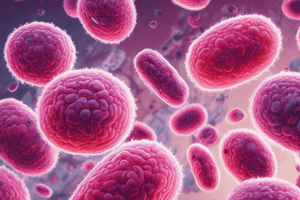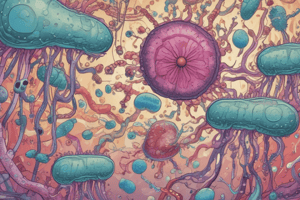Podcast
Questions and Answers
Match the following Staph. aureus infections with their descriptions:
Match the following Staph. aureus infections with their descriptions:
Folliculitis = Inflammation of hair follicle or oil gland Furuncles = Boils, superficial Carbuncles = Large more invasive lesions, develop from multiple furuncles Impetigo = Large pustules, very contagious
Match the following bacteria with their description:
Match the following bacteria with their description:
Staphylococcus aureus = Most virulent species of Staph, normal flora of Skin and Mucus membranes Streptococcus pyogenes = Colonizes upper respiratory tract, clinically significant if found
Match the following Staph. aureus virulence factors with their functions:
Match the following Staph. aureus virulence factors with their functions:
Enzymes = Help infection to easily spread Cytolytic toxins = Hemolysins and leucocidins Protein A = Antiphagocytic Enterotoxins = Heat-stable, cause diarrhea and vomiting
Match the following Staph. aureus syndromes with their descriptions:
Match the following Staph. aureus syndromes with their descriptions:
Match the following Staph. aureus routes of infection:
Match the following Staph. aureus routes of infection:
Match the following Streptococcus pyogenes characteristics:
Match the following Streptococcus pyogenes characteristics:
Match the following portals for Staph. aureus:
Match the following portals for Staph. aureus:
Match the following bacteria with their associated symptoms or characteristics:
Match the following bacteria with their associated symptoms or characteristics:
Match the following bacteria with their virulence factors:
Match the following bacteria with their virulence factors:
Match the following diseases with their common cause:
Match the following diseases with their common cause:
Match the following bacteria with their method of spread:
Match the following bacteria with their method of spread:
Match the following bacteria with their portal of entry or exit:
Match the following bacteria with their portal of entry or exit:
Match the following bacteria with their associated diseases:
Match the following bacteria with their associated diseases:
Match the bacteria with their reservoirs:
Match the bacteria with their reservoirs:
Match the following bacteria with their associated conditions:
Match the following bacteria with their associated conditions:
Match the following bacteria with their characteristics:
Match the following bacteria with their characteristics:
Match the following bacteria with their optimal growth temperature:
Match the following bacteria with their optimal growth temperature:
Match the following bacteria with their transmission routes:
Match the following bacteria with their transmission routes:
Match the following bacteria with their associated diseases:
Match the following bacteria with their associated diseases:
Match the following diseases with their symptoms:
Match the following diseases with their symptoms:
Match the following diseases with their treatment:
Match the following diseases with their treatment:
Match the following Vibrio cholerae strains with their associated diseases:
Match the following Vibrio cholerae strains with their associated diseases:
Match the following Vibrio cholerae strains with their characteristics:
Match the following Vibrio cholerae strains with their characteristics:
Match the following bacteria with their associated diseases:
Match the following bacteria with their associated diseases:
Match the following bacteria with their virulence factors:
Match the following bacteria with their virulence factors:
Match the following bacteria with their portals of entry and exit:
Match the following bacteria with their portals of entry and exit:
Match the following bacteria with their transmission methods:
Match the following bacteria with their transmission methods:
Match the following bacteria with their characteristics:
Match the following bacteria with their characteristics:
Match the following Neisseria infections with their symptoms:
Match the following Neisseria infections with their symptoms:
Match the following bacteria with their exceptions:
Match the following bacteria with their exceptions:
Flashcards are hidden until you start studying
Study Notes
Bacterial Infections and Characteristics
- Staph.aureus infections can be matched with their descriptions, including various types of infections and syndromes.
- Staph.aureus virulence factors have specific functions, such as facilitating infection and immune evasion.
- Staph.aureus syndromes, including skin and soft tissue infections, respiratory infections, and others, have distinct descriptions.
- Routes of infection for Staph.aureus include direct contact, airborne transmission, and contaminated fomites.
- Streptococcus pyogenes characteristics include beta-hemolytic activity, gram-positive staining, and others.
- Portals for Staph.aureus infection include skin, respiratory tract, and urinary tract.
- Various bacteria, including Staph.aureus and Streptococcus pyogenes, are associated with specific symptoms and characteristics.
- Bacterial virulence factors, including toxins and adhesins, contribute to disease pathogenesis.
- Certain diseases, such as pneumonia and meningitis, have common causes, including Staph.aureus and Streptococcus pyogenes.
- Methods of spread for bacteria include direct contact, airborne transmission, and contaminated fomites.
- Portals of entry and exit for bacteria include skin, respiratory tract, and urinary tract.
- Bacterial reservoirs, including humans, animals, and environment, can harbor and transmit bacteria.
- Associated conditions, including skin and soft tissue infections, respiratory infections, and others, are linked to specific bacteria.
- Bacterial characteristics, including morphology, gram staining, and growth requirements, are used to identify and classify bacteria.
- Optimal growth temperatures for bacteria, including mesophilic and thermophilic temperatures, vary among species.
- Transmission routes for bacteria, including direct contact, airborne transmission, and contaminated fomites, contribute to disease spread.
- Associated diseases, including pneumonia and meningitis, are linked to specific bacteria, such as Staph.aureus and Streptococcus pyogenes.
- Disease symptoms, including fever, cough, and others, are associated with specific bacterial infections.
- Disease treatment, including antibiotic therapy and supportive care, depends on the type of bacterial infection.
- Vibrio cholerae strains, including O1 and O139, are associated with specific diseases, including cholera.
- Vibrio cholerae strains have distinct characteristics, including gram-negative staining and curved morphology.
- Neisseria infections, including meningitis and gonorrhea, have distinct symptoms and treatment options.
- Bacterial exceptions, including L-forms and mycoplasmas, have unique characteristics and growth requirements.
Studying That Suits You
Use AI to generate personalized quizzes and flashcards to suit your learning preferences.



